Origin France | Place of origin France | |
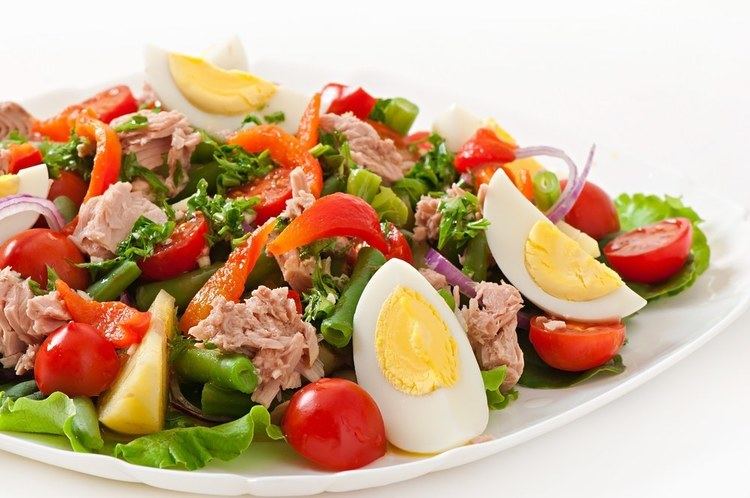 | ||
Similar Tomato, Egg as food, Onion, Tuna, Olive | ||
Jacques maximin la salade ni oise recette
Salade niçoise ([niˈswaz]), la salada nissarda in the Niçard dialect of the Occitan language, is a salad that originated in the French city of Nice. It is traditionally made of tomatoes, hard-boiled eggs, Niçoise olives, anchovies, and dressed with olive oil. It has been popular worldwide since the early 20th century, and has been prepared and discussed by many famous chefs. Delia Smith called it "one of the best combinations of salad ingredients ever invented" and Gordon Ramsay said that "it must be the finest summer salad of all."
Contents
- Jacques maximin la salade ni oise recette
- Recette pour faire une vraie salade ni oise
- Traditional recipe and its defenders
- Variations by chefs and food writers
- Notable chefs
- References
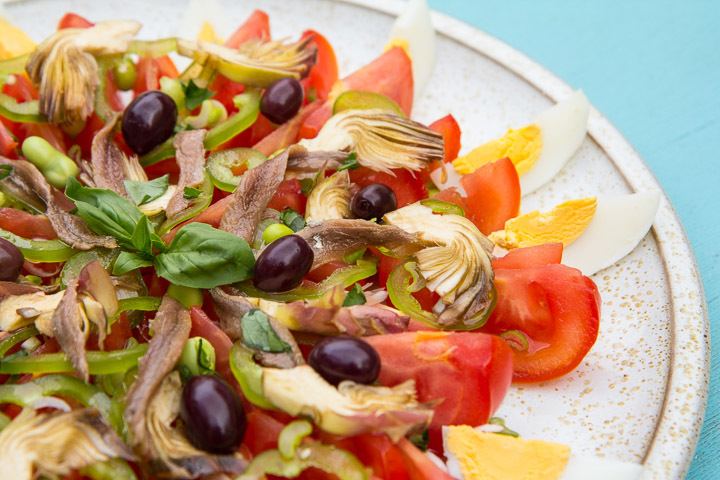
It can be served either as a composed salad or as a tossed salad. Freshly cooked or canned tuna may be used. For decades, there has been significant disagreement between traditionalists and innovators regarding which ingredients should and should not be included in a salade niçoise. According to traditionalists, it excludes cooked vegetables. The salad may include raw red peppers, shallots, artichoke hearts and other seasonal raw vegetables. Raw green beans harvested in the spring, when they are still young and crisp, may be included. However, cooked green beans and potatoes are commonly served in variations of salade niçoise that are popular around the world.
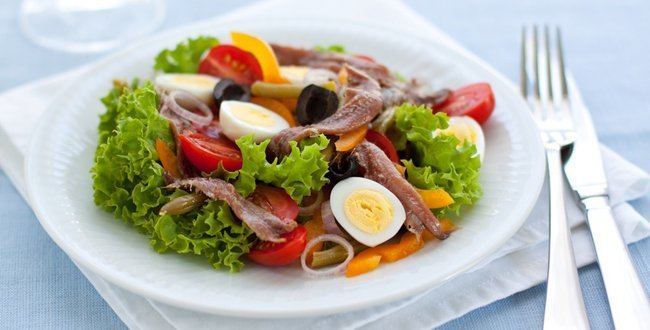
Recette pour faire une vraie salade ni oise
Traditional recipe and its defenders
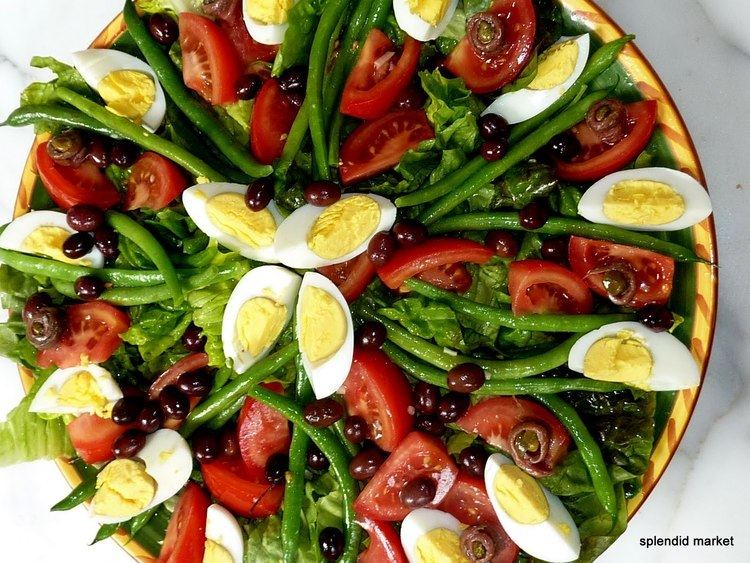
The version known in Nice in the late 19th century was a basic combination of tomatoes, anchovies and olive oil, described as "simple food for poor people". Over time, other fresh and mostly raw ingredients were added to the salad as served in Nice. A 1903 recipe by Henri Heyraud in a book called La Cuisine à Nice included tomatoes, anchovies, artichokes, olive oil, red peppers and black olives, but excluded tuna and lettuce. The dressing included olive oil, vinegar, mustard and fines herbes.
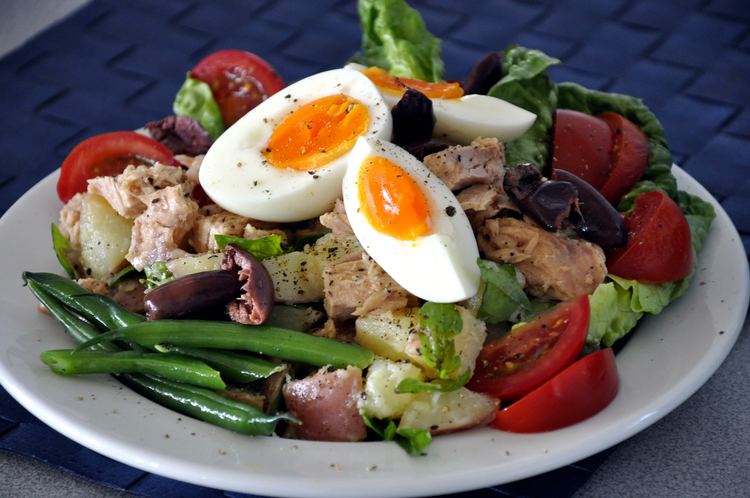
Former Nice mayor and cookbook author Jacques Médecin was a strict salad traditionalist. His 1972 cookbook Cuisine Nicoise: Recipes from a Mediterranean Kitchen called for the salad to be served in a wooden bowl rubbed with garlic, and excluded boiled vegetables: "never, never, I beg you, include boiled potato or any other boiled vegetable in your salade niçoise." Médecin wrote that the salad should be made "predominately of tomatoes" which should be "salted three times and moistened with olive oil". Hard-boiled eggs were added, and either anchovies or canned tuna, but not both. He incorporated raw vegetables such as cucumbers, purple artichokes, green peppers, fava beans, spring onions, black olives, basil and garlic, but no lettuce or vinegar. According to Rowley Leigh, Médecin believed that salade niçoise "was a product of the sun and had to be vibrant with the crisp, sweet flavours of the vegetables of the Midi." Médecin advocated presenting the dish as a composed salad, commenting, "As the various ingredients that go into salade niçoise are of bright and contrasting colours, they can be arranged most decoratively in the salad bowl."

An organization called Cercle de la Capelina d’Or, led for many years by Renée Graglia until her death in 2013, continues to protest against deviation from traditional local recipes. The group, which certifies restaurants in Nice, sticks with Médecin's standards. They reject commonly included ingredients such as green beans and potatoes, as well as innovations such as including sweetcorn, mayonnaise, shallots and lemon.
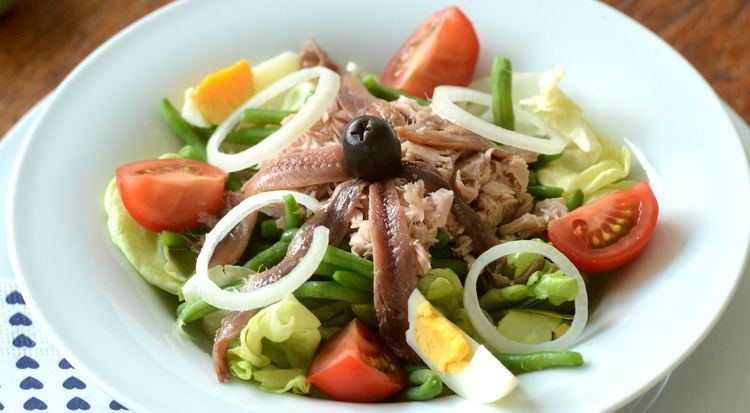
In 2016, French Michelin-starred chef Hélène Darroze posted a salade niçoise recipe on Facebook that included cooked potatoes and green beans. According to journalist Mathilde Frénois, the reaction on Facebook was quick and hostile from the "purists". Darroze's version was called "a massacre of the recipe", a "sacrilege", and a violation of the "ancestral traditions" of the salad. She was warned that it is "dangerous to innovate".
Variations by chefs and food writers
The question of the proper ingredients appropriate for a salade niçoise has long been the subject of debate and even controversy. Nigella Lawson observed "Everyone seems to have a very strong opinion as to what should or should not go into a Salade Nicoise".
Famed chef and cookbook author Auguste Escoffier (1846–1935), born in Villeneuve-Loubet near Nice, added potatoes and green beans to the traditional recipe, an innovation that remains controversial as a "questionable idea" a century later.
Salad niçoise has been known in the United States since at least the 1920s, when a cookbook for hotel chefs included two variations. The first was vegetarian, was dressed with mayonnaise, and included lettuce, tomatoes, potatoes, stringless beans and pimento-stuffed olives, while the second version was a composed salad, including the same ingredients, plus anchovies.
A 1941 U.S. version by chef Louis Diat of the Ritz-Carlton Hotel included the anchovies, was dressed with vinaigrette, and added capers.
The highly influential 1961 American cookbook, Mastering the Art of French Cooking, included a recipe that incorporated a potato salad, green beans, both tuna and anchovies and a vinaigrette dressing. Co-author Julia Child later demonstrated the recipe on her television show, The French Chef, in 1970.
A recipe was included in Prosper Montagné's Larousse Gastronomique in 1938. It called for "equal parts diced potatoes and French beans. Season with oil, vinegar, salt and pepper. Mix with anchovy fillets, olives and capers. Garnish with quartered tomatoes."
French chef Paul Bocuse included a vegetarian version of the salad, garnished with chopped onion and chervil, in the 1977 English translation of his cookbook.
A 1979 variation by Pierre Franey is called Salade Niçoise aux Poires d'Avocat. Franey wrote, "I am convinced that had avocados been native to Provence they would have been an inevitable ingredient in the celebrated salad of that region, the salad niçoise." This version also included mushrooms and both black and green olives.
Claudia Roden is an advocate of innovation, who observed in 1984 that "There are not one or two or three versions of salade Nicoise — but dozens, depending on what is available."
In 1984, James Beard created a version incorporating rice for an Uncle Ben's advertising campaign.
In 1991, Jacques Pépin wrote an article that called the inclusion of canned tuna the "conventional choice", and recommended sauteed fresh tuna instead as "more elegant". Mimi Sheraton disagrees, commenting, "Salade Nicoise with fresh tuna is a travesty . . . if you like it, you are wrong!" In 1999, Pépin joined with Julia Child in a TV series, Jacques and Julia: Cooking at Home. Each prepared a salad they called "Near Nicoise". Child's version was a composed salad including tuna and anchovies canned in olive oil, and blanched green beans. Pépin's was a tossed salad including sauteed fresh tuna and potatoes.
Many chefs have developed variations using seafood other than anchovies or tuna. Ina Garten, Jamie Oliver and Rachael Ray have published variations using salmon as the fish component. Bobby Flay has published variations incorporating shrimp and swordfish both of which he describes as "Nicoise" in quotation marks. Sara Moulton also has a recipe incorporating shrimp. Instead of a conventional salad dressing, she uses an Italian tuna sauce. A wide variety of seafoods can be used in non-traditional variations, with San Francisco chef Jay Harlow commenting, "Mackerel, and even milder fish like rockfish, cod or halibut are also delicious served this way, as are good canned sardines."
Nigella Lawson has published a quick recipe that substitutes croutons for potatoes.
Cat Cora has published a variation that presents the salad as a lettuce wrap.
Emeril Lagasse has a recipe that uses a mayonnaise based creamy Parmesan dressing, and incorporates grilled Yellowfin tuna loin along with Picholine olives in addition to the traditional black olives.
Guy Fieri has a recipe that incorporates couscous and mushrooms.
Sandra Lee has a version that includes tuna steaks stuffed with olive tapenade.
Mark Bittman has a variation that incorporates farro.
Notable chefs
Many other chefs and food writers have written recipes for the salad. Among them are Daniel Boulud, Anthony Bourdain, Ina Garten, Melissa d'Arabian, Hélène Darroze, Tyler Florence, Simon Hopkinson, Robert Irvine, Tom Kerridge, Gordon Ramsay, Nigel Slater, Delia Smith, Martha Stewart, Michael Symon and Alice Waters.
